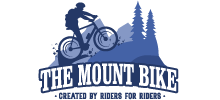Everywhere you go, people talk about the benefits of mountain biking. They gush about the thrill of seeing new routes and exploring new places. But then you spend a day on your bike and realize they’re just talking to sound harsh because they’re scared to ride.
In this article, we’ll answer the all-important Mountain Bikes 101 question. The question that plagues the minds of every newbie out there.
Types of Bike
We’re just gonna talk about the two main types. You see me talk about in these videos are a full suspension mountain bike and a hardtail.
- Hardtail
Now let’s start with the hardtail. A hardtail is called a hardtail because the bike’s rear has no suspension. The front fork is the only place you’ll find suspension on a hardtail.
Both bike categories have suspension forks, and a full suspension bike has a shock in the rear, allowing the bike to compress in both the front and the rear.
Now on hardtails and full-suspension bikes, you’ll hear us talk about travel; travel is how much the suspension compresses.
You start to run out of options on the hardtail. This will take up the impact much better, but still, you almost always see me riding a hardtail on this channel. It’ll also be snappier, more rigid, and easier to throw around.
- Full Suspension
Now with all that said, full-suspension Mountain bikes have made a lot of things possible that weren’t before.
The types of drops and gap jump and things people are doing on mountain bikes now are more significant and gnarly than they’ve ever been in history.
And we owe a lot of that to modern full-suspension bikes. Now, in addition to being lightweight and having suspension, modern mountain bikes have another feature: a dropper seat post. You push this button up on the handlebars.
You can drop the seat post down, and when you want to raise it back up, you push that same button on the handlebars, and it goes up.
The Basic Anatomy of a Mountain
So the next thing we want to bring you up to speed on is the basic anatomy of a mountain bike because we always refer to different parts.
- Crank Sat and the Front Sprocket
This area right here is the bottom bracket. That’s where the crank sat and the front sprocket and everything attached.
- Fork, the Stem and the Handlebars
Now, this area up here where the fork and the stem and the handlebars attached to that is the head tube, this piece of the frame, and this whole area of the bike on the handlebars.
- Wheel
This next one seems really obvious, but this is a wheel and the reason we even mentioned that is that you’ll hear people call it a rim, and you’ll hear people call it a tire.
Those are different components of a wheel on a wheel. You’ve got the tire, the rim, you have the spokes and then you have the hub, this piece in the middle.
- Thru-Axle
And on most modern mountain bikes, you’re going to have a thru-axle, which is an axle that we can remove from here to take the bike apart and load into the trunk of a car.
So oftentimes, you’ll hear us refer to gears or speeds. Gears and speeds are the same things.
If you look at a mountain bike and count the number of little gears on the rear cassette, this is called a cassette; you’ll know how many speeds it has or how many gears it has.
This is a 12-speed on this bike, we have an 11-speed has fewer gears. The more gears you’ve, the smaller the increments between different gears. So you can achieve exactly the type of peddling feeling that you want.
Tire Sealant
We’ve all sorts of goopy fluids; there’s, there’s grease, there’s tire sealant, there’s brake, oil, fork, oil, and shock, oil, car fiber grip.
But the one that we get the most comments about is the tire sealant. So let us explain to you what that is. So, if you’ve ever changed a flat on a bike, or tire as a kid, you remember inner tubes.
So you’ve got your tire, you got a tube inside of it, this is what holds the air, everything’s dandy. Of course, if you get a puncture, the inner tube must be replaced or patched. And if you get a pinch flat, the inner tube is gonna go as well.
Rule and Regulation of Trailhead
Sometimes there’ll be multiple trailheads in a given trail system. But here we’re at the main trailhead where you park your car, you get off your bike and you go in for a ride.
So at a trailhead, you’re typically going to have some kind of a kiosk that’s gonna have maps on it.
- Signage
At the beginning of most trails, there’s going to be some signage to tell you what to expect. As you can see on this trail, bikes are allowed, but also horses and hikers are allowed.
There’s also a difficulty sign; this one is sort of intermediate because you can see there’s a blue square on there; a black diamond would be really hard. A green circle will be straightforward.
- Fire Road
So right here, this is considered a fire road. Now you’ll see similar roads referred to two as jeep roads, double track, basically an access road for emergency vehicles, maintenance, and things like that.
It’s also a place where you can pedal your bike out to trails. There are many trail systems where you’ve multi-directional trails going up and down the mountain and you don’t want to climb a trail that people will be coming down really fast.
- Single Track
So this right here is single track; this is what we come out to ride. It’s no fun riding on a big wide gravel road. We want to ride something that’s narrow and fast and windy and flowy.
In fact, the word flowy is perfect to describe this trail doesn’t have many rocks on, it doesn’t have many features, and it’s just windy and smooth.
But there are also trails that we would describe as technical; they’re gonna feature drops and rocks and terrain that take a little doing to navigate.
Mountain Bike Gadgets for Self-Protection
If you’re just riding a local cross-country trail, you might have nothing on but a helmet. We just showed probably going to have a helmet and knee pads on. At the very least; gloves are a good idea. Because your hands get sweaty and they move around the handlebars.
- Dirt Jump Helmet
For instance, a dirt jump helmet is made for maximum visibility and protection.
So when you’ve it on, you can see the helmets, not in your peripheral, but it’s gonna protect the side’s top of your head really well.
- Trail Helmet
Now a trail helmet, we call it a half-lit, half-shell. This type of helmet is made for ventilation. You’re going to exert a lot of physical energy when riding a normal mountain bike trail climbing and moving the bike around.
So it’s got all these vents so that when you’re going forward cools off your head, it’s also very lightweight, but it still offers the protection you need front and back inside.
- Protective Gear
And indeed all protective gear comes in different forms. If you’re just doing some light riding, knee pads like this will be enough to keep the skin from scraping off your knees, knee pads like these are way heavier and harder to pet Ellen.
But they’ve way more padding and afford more protection. So if you’re doing something gnarly, you can use these or climb with them in your pack.
- Biking Jersey and Shorts
This is a mountain biking jersey; it wicks moisture really easily. It keeps you nice and cool and doesn’t irritate your skin as it moves around.
These are mountain bike shorts; they’re made to be worn with a shammy underneath. It’s like a padded pair of shorts that keep the seat from hurting all your stuff up there.
What to Do About Trail Dirt?
So one thing you hear mountain bikers talk about a lot is dirt. The dirt was perfect, it was hero dirt. The dirt was amazing.
Good dirt is normally a reference to the consistency of the soil and the properties that make it good for grip and riding a mountain bike.
What Is MTB Feature?
You’ll often hear us refer to features such as a ramp, a jump, a drop, a rock garden, or anything on the trail of note.
- Jump
One common feature type is a jump; all jumps start with a lip. The lip is the part that launches you up in the air; right over here, we have the driveway jump, and the lip is made of these wouldn’t banks over here.
You take off from the gravel road on one of a few rock lips, and then you land a little bit lower down on the landing.
- Drop
A drop in any time you’re going from an area of high elevation to low elevation really abruptly, but you’re not gaining any elevation off of it; you’re just dropping.
- Skinny
One feature that you’ve heard us refer to tons of times is a skinny or skinny line. All of it’s some kind of narrow feature that you’ve to traverse. It can be in the form of a ladder bridge, a log ride, a skinny rock, or, anything
- Rock Garden
So here we’re at the rock garden and most of you’re familiar with what this is now; just because you’re riding through rocks doesn’t mean you’re riding through a rock garden.
There are some trails where the entire trail is rock. Usually, when referring to a rock garden, you’re referring to an area where you abruptly encounter a bunch of rocks.
- Berms
Now, berms are usually made out of dirt, but they can be made of wood, and of course, Berm Peak gets its namesake from the word berm, it’s like an embankment.
Term We Used in MTB
- Baling
The first one is baling is when you’re up in the air on your bike or going down some kind of a feature and you realize that things are headed south; you’ve to get off your bike when you fall off the bike.
What’s usually going to hurt you the most is the bike itself; you can get tangled up in it, and you can fall on top of it.
With the handlebars sticking out, you want to get away from the bike as fast as possible; bailing refers to chucking in the bike, getting away from it, and aborting the mission.
- Hooking
When you use the word huck, it’s never used to describe kind of a purpose-built to jump, it’s always. You’ve to do something a little extra to make it work.
So if there’s a rock over here and you have to jump to this one, you don’t quite have enough speed. You have to hook it, and you have to pull up on the bike as hard as you can and just make it.
Now hook the flat is when you’re hooking something and the landing is just completely flat.
- Casing
You know, you’re in trouble when you hear somebody talking about casing. It’s not good and it refers to coming up short on a jump.
So if you were to, let’s say, take off from here, get your front wheel onto this landing, but your back wheel doesn’t quite make it.
And for that type of case, you’re going to need a lawyer. Now the very worst type of case is a nose case.
That’s when you’re headed towards the back of a landing with the nose of your bike, the front wheel and there’s no law that’s going to be able to help you get out of that case.
- Roosting A Berm
When you hit it so hard and fast with no breaks, your tires are digging in and spitting stuff everywhere. Not good for the berm, but if you have that much speed, it’s gonna happen.
Now sometimes you see somebody put on their brakes on a berm and try to like fake roost; that’s not roosting but just skidding through a berm; that’s stupid and rex berms.
So as we discuss, the whale tail is a double, but this particular double isn’t straight; you take off this way and the landings over here, so you’ve to kind of turn right in the air.
- Hip Jump
Some hip jumps are very mild, like this one, and you’re turning a full 90 degrees in other hip jumps. So the last time we wanted to find his bike park, you’ll hear us refer to bike parks all the time.
- Bike Park
The key is a bike park is purpose-built for just bikes. You’re not supposed to hike there; you’re not supposed to ride horses there. We need more bike parks.
FAQs
How do I learn to mountain bike?
The first step is to go to a bike store and ask for the help of an expert. Bring your biking gear with you, so they can tell you if you need any specific gear. For beginners, mountain biking can be a little more difficult because you’ve to balance on trails with obstacles. Therefore, it’s essential to start slowly and work your way up.
When should you shift gears on a mountain bike?
The best time to shift your gears is when you’re in a tight spot. Mountain biking is all about finding a good balance between control and speed. Shifting gears allows you to make more power and control the bike so it can ride through obstacles easily.
How challenging is mountain biking?
Mountain biking is one of the most challenging forms of biking. You must learn to balance on a bike and control it when going through trails and obstacles. You can’t just focus on speed, but rather balance and control as well.
Final Word
So that’s it. We oversimplified and left tons of things out for the sake of brevity. The goal here today was to give a little bit of context and clarity to the mountain bikes 101 – questions you were too embarrassed to ask.
If you’re content to just sit by the sidelines and watch our mountain bike, we can’t tell you how much we appreciate it and welcome you.

I am Ryan Ford, a mountain biking enthusiast who loves to explore the outdoors. I also like to go on adventures with friends and anything else that involves being outside. I love my bike because it gets me out of the house and gives me an opportunity to enjoy nature.

